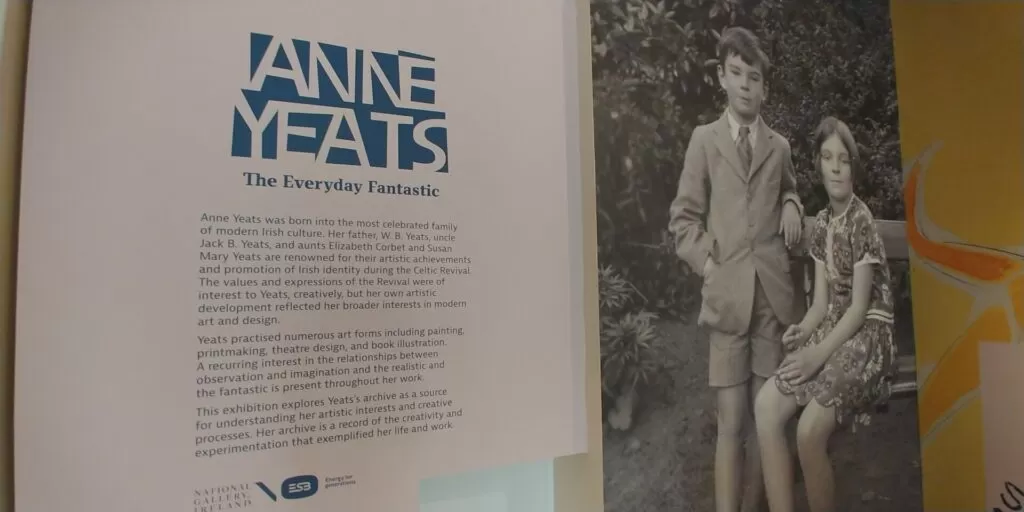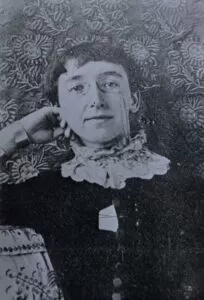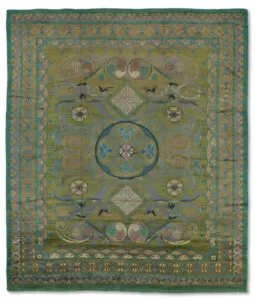Arts & Crafts Across the Sea: Harry Clarke, the Dun Emer Industries, and Donegal Designs
by Kate Nixon
Have you ever gone on a foreign trip, only to come back and find little reminders of your experience for months and months on end? I’m not just talking about images captured through your high pixel capturing device of choice.
During last year’s trip to the emerald isle, I was intent on finding hints of the Irish Arts and Crafts movement as shown in the publication The Arts & Crafts Movement: Making It Irish. One such leading example was expressed by the vibrantly colorful stained glass catalog of works from artist Harry Clarke – an artist whom I was reminded of when I saw a glass panel up for bid in the Temple of the Wings auction earlier this month.
This Acid-etched and stained glass illuminated mahogany and fruitwood box, signed and dated 1922, was featured in the online auction “The Ann and Gordon Getty Collection: Early Modern Design from Temple of Wings” last month. The box ($5,000-$7,000) sold at a realized price of $47,880.
I had written about the works of Harry Clarke previously and truly admired the panel Titania Enchanting Bottom for Clarke’s tribute to the Shakespearean classic.
And because it’s Christie’s and the Temple of Wings collection, I knew I wasn’t the only one admiring this small box. Its estimates ($5,000-7,000) were blown out of the water as it finally sold for the price of $47,880. Fun fact: before this stained glass illuminated mahogany and fruitwood box came to be in the possession of Ann and Gordon Getty, this work of art was owned by Sir Robert Woods, a noted surgeon, otorhinolaryngologist, and Independent Unionist Member of the UK House of Parliament. This decorative panel has quite the history and so did its designer.
It was neat to see that name again in such a prestigious collection, but two other names caught my attention: the Dun Emer Guild and Donnegal carpets. While exploring Dublin’s National Gallery of Art, I came across an exhibition on Anne Yeats, daughter of the acclaimed W.B. Yeats. As it turns out, the Yeats family had an important connection to the Irish Arts and Crafts movement through the Dun Emer Guild and Dun Emer Press, both arms of Dun Emer Industries.
Evelyn Gleeson, founder of the Dun Emer Guild and arts and crafts artist. Photo courtesy of Wikimedia Commons.
The Dun Emer Guild was founded by Evelyn Gleeson, who studied design under Alexander Millar, an influential member of the British Arts and Crafts community. Evelyn partially funded the beginnings of Dun Emer Industries and took on two new partners in her venture: Elizabeth and Lily Yeats, sisters to W.B. Yeats. Started in Gleeson’s rented house in Dundrum, Gleeson started the guild in order to encourage locals to use the local materials at hand to create beautiful handicrafts. Much like guilds and craftsfirms within the American Arts and Crafts movement, the guild aimed to train women and eventually hire them in the field of the decorative arts: in the arts of weaving and tapestry creation with Gleason leading that department, Elizabeth Yeats training in the art of the printing press, and Lily Yeats training in the art of embroidery. The guild was invariably linked to the local Irish literary movement with the involvement of the Yeats sisters with their famous brother W.B.publishing their first book through the aptly named Dun Emer Press. With both the Dun Emer Press and the Dun Emer Guild working in the same house, the house operated under the name Dun Emer Industries.
A “Donegal Carpet” made from the Dun Emer Guild circa 1900 offered as part of the Temple of Wings auction from the Ann and Gordon Getty collection last month. The carpet ($10,000-$15,000) sold for $30,240.
The carpets in particular were famous in local exhibitions, winning prizes even in the Royal Dublin Society-run show. The guild even exhibited in the 1904 St. Louis World’s Fair as part of the Irish Industrial Exhibition, with their Celtic knotwork designs setting their motifs apart. Unfortunately, the partnership between Gleeson and the Yeats sisters was strained due to the lack of sales. While Gleeson attempted to adapt her carpet designs from Irish manuscripts showing the bright color palette of the Irish landscape, the Dun Emer press was under the editorial power of W.B. and its first book, while a beautiful example, put them at a financial loss. Things came to a head as three equally creative and powerful partners headbutted on ideas on a small budget. After six years in partnership, the Yeats family left Dun Emer to create the independent Cuala Press and Gleeson kept the Dun Emer Industries. The Dun Emer name expanded on other local handicrafts, while the Cuala Press became the only press involved in the local Arts and Crafts movement, the only press to be completely staffed and run by women, and the only private press to publish contemporary works and be closely connected with the Irish Literary Revival. Anne Yeats, daughter of W.B., would take over the Cuala Press with her brother Michael in 1969.
The above example, featured during last month’s Temple of Wings auction and part of the Ann and Gordon Getty collection, is an example of the Donegal carpet: other examples of the Donegal carpet can be found in Dublin Castle, Notre Dame University and even in the White House. Founded by Scottish textile designer Alexander Morton, the Donegal carpet is a trademarked brand of carpet with Celtic designs, first exhibited at the Cork Exhibition of 1902. The carpet was noted particularly for using vegetable dyes for its vibrant colors and the use of the handspun wool by locals. Its Arts and Crafts era textile examples stand next to those of William Morris as examples of the finest carpets to originate from Europe, paying tribute to the handcrafted with local materials.
While I got plenty of exposure to the Irish Arts and Crafts movement in last year’s trip, there are so many examples of textile firms and perhaps other early 20th Century firms out there waiting to be discovered. During a time of extremes and upset, the need for craftsmanship and for empowerment of the women of Ireland was met by Dun Emer Industries.
Perhaps another research trip back to the Emerald isle is in order for the not-too-distant future.
Stay tuned for next week’s blast when Bruce Johnson returns to reveal his study of two women in America who kept the same concepts of local craftsmanship going here in Asheville, North Carolina.




